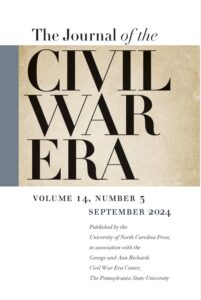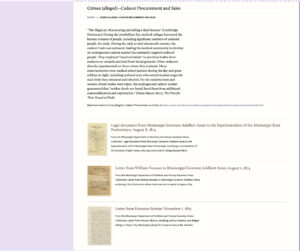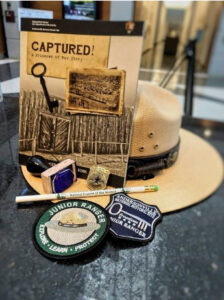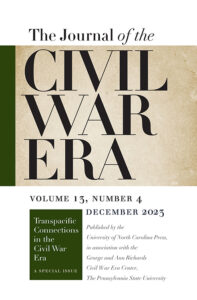
Editors’s Note for June 2024 JCWE
This issue demonstrates the ongoing methodological breadth of the Civil War Era, as scholars bring numerous different ways of approaching history to reckon with the turbulent mid-nineteenth century in all its facets. This issue includes one research article, a book award talk, a roundtable, and a historiographic review essay, along ...
Read More
Read More
Exit Interview with Hilary Green
What has been the most rewarding part of your time with Muster? It has been rewarding to introduce the amazing work of more diverse Civil War era scholars to more diverse audiences of academic, K-12, and non-academic audiences. As such, I have been able to see more people engage with their ...
Read More
Read More

Production by Enslaved Workers and the US GNP
Sad to say, the gulf between economic history and mainstream history is as wide today as ever. Undoubtedly many forces have contributed to this state of affairs, but one historical breakpoint was the controversy over slavery during the 1970s, prompted by publication of Time on the Cross, by Robert ...
Read More
Read More

2024 Tom Watson Brown Book Prize Winner
The Society of Civil War Historians and the Watson-Brown Foundation are proud to announce that Yael A. Sternhell is the recipient of the 2024 Tom Watson Brown Book Award. Dr. Sternhell earned the award for War on Record: The Archive and the Afterlife of the Civil War which was published in ...
Read More
Read More

Uncovering Black Voices in Civil War Era Digital Archives: The Civil War & Reconstruction Governors of Mississippi Project
While pondering the future of digital history, historian Edward L. Ayers argues the field should not only replicate archives and build new tools. It must also feature interpretation, explanation, and explication, and when it accomplishes these things, it can contribute original knowledge and perform a democratic service in meaningful and ...
Read More
Read More
Introducing the New Digital Media Editor
The Journal of the Civil War Era is pleased to announce that Dr. Robert Bland will become the journal’s new Digital Media Editor in June. He succeeds Dr. Hilary Green, who served as Digital Media Editor since 2020. Dr. Bland is assistant professor of History and Africana Studies at the University ...
Read More
Read More

Andersonville is Black History and Reconstruction History (even when the National Park Service Forgets)
Junior Ranger programs are popular educational activities at our national parks. Children complete a short exercise connected to the park’s theme and receive a badge. The best junior ranger programs provoke age-appropriate revelation about the big picture without merely simplifying the material presented to adults. Andersonville National Historic Site’s standing ...
Read More
Read More
How the Federal Government Came to Control Immigration Policy and Why it Matters
The Civil War and Reconstruction transformed immigration policy in the United States, marking the transition from a sub-national to a national policy for regulating the admission, exclusion, and removal of foreigners. Before that turning point, Congress played almost no role in regulating immigration, other than naturalization policy (for white people) ...
Read More
Read More

Previewing the March 2024 JCWE
Questions of slavery, freedom, and violence are at the heart of this journal issue. For decades, historians have described how enslaved people during the Civil War saw new possibilities for escape with the presence of US military forces nearby, and how profoundly their actions shaped the course of the war ...
Read More
Read More
Beyond the Book Review: A Conversation with Chad Pearson
Editor's Note: This is the first in a series of recorded interviews between the JCWE book review editor and the authors of the works reviewed in the journal. ****** Those who study the Civil War and Reconstruction are all too familiar with acts of terror, especially those committed by white ...
Read More
Read More
Author Interview: Hidetaka Hirota
Today we share an interview with Hidetaka Hirota who edited the December 2023 JCWE special issue on the transpacific connections in the Civil War era. Hidetaka Hirota is an associate professor of history at the University of California, Berkeley. He is the author of Expelling the Poor: Atlantic Seaboard States and ...
Read More
Read More
Author Interview: Tian Xu
Today we share an interview with Tian Xu, who published an article in the December 2023 JCWE, titled “Chinese Women and Habeas Corpus Hearings in California.” Tian Xu is a postdoctoral fellow at SUNY Buffalo’s Baldy Center for Law and Social Policy. His work has been published in Journal of ...
Read More
Read More
Author Interview: Beth Lew-Williams
Today we share an interview with Beth Lew-Williams, who published an article in the December 2023 JCWE, titled “Chinese Naturalization, Voting, and Other Impossible Acts.” Beth Lew-Williams is an associate professor of history at Princeton University. She is a historian of race and migration in the United States, specializing in Asian ...
Read More
Read More
Author Interview: Stacey Smith
Today we share an interview with Stacey L. Smith, who published an article in the December 2023 JCWE, titled “The Colored American Asiatic Traveler”: Peter K. L. Cole and American Empire in Japan.” Stacey L. Smith is an associate professor of history at Oregon State University. She is the author of ...
Read More
Read More

Preview of December JCWE and the Transpacific Connections Forum
In the late nineteenth century, opponents of Asian immigration on the West Coast claimed slavery was being resurrected in the United States. The escalation of industrial capitalism in the postbellum years had already established the perception among American workers that capitalists were attempting to enslave them as exploitable labor. As ...
Read More
Read More

Congratulations to the 2023 Anne Braden Prize Winner
The Southern Historical Association is delighted to announce the winner of the Anne Braden Prize: Kimberly Welch, “The Stability of Fortunes: A Free Black Woman, Her Legacy, and the Legal Archive in Antebellum New Orleans,” JOURNAL OF THE CIVIL WAR ERA 12 (December 2022): 473-502. This prize, which was first ...
Read More
Read More